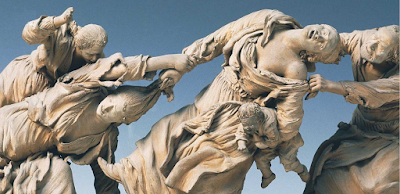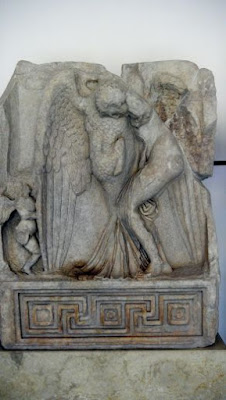But he was not impressed. He notes that both authors see our problems in much the same way:
Both are appalled by the collusion between the federal government and corporations. Both describe the legal system as essentially lawless. Neither has any faith that electoral politics, the three branches of government or the Constitution itself can make a difference. Neither fits with any sizable faction of either of the two parties. Both despise elites. Both are willing, even eager, to see Americans break the law, in nonviolent ways, to force change.But they disagree about much else:
Of course, Murray and Hedges are not after the same thing. We live in a truly and, for now, insuperably divided country — divided even by its populisms. Neither writer would have any patience for the assumptions or values of the other, and in fact it’s hard to imagine anyone with Murray’s views bothering to read Hedges’ book, or vice versa, since both are written explicitly for the like-minded.According to Packer, the leftist Hedges has virtually nothing to offer in the way of a plan:
“We live in a revolutionary moment,” Hedges, the author of American Fascists and other books, asserts in his first sentence. This doesn’t seem remotely true to me, but I would have listened to an argument (why, how, by whom, to reorder politics and economics on what principles, dealing with the inevitable problems in what way). Hedges doesn’t have an argument. What he has is a tremendous amount of rhetoric, flecked with literary asides on Melville and Fitzgerald, and reverential portraits of rebels, from Subcomandante Marcos to the defrocked lawyer Lynne Stewart.Charles Murray used to have a plan of sorts, arguing for capitalism restrained only by religious principles, with a minimal or "Madisonian" government. But according to Packer he has moved on from that idea:
Murray himself no longer wants to see deep cuts in taxes and income transfers. The collapse of the American working class has pushed him away from the harsh, Scrooge-like thinking of Losing Ground and The Bell Curve to the more complex analysis of his most recent book, Coming Apart.Which I think is great, but if libertarians no longer think laissez faire economics will solve our problems, what do they think? Instead of his wicked (I think) but at least understandable policies, Murray now has a scheme to restrain the Federal government by massive civil disobedience:
The purpose of By the People is to propose a campaign of nonviolent civil disobedience. Across the country, fed-up Americans will stop complying with regulations that are indisputably ridiculous, while moneyed Madisonians will establish “defense funds” to pay their legal fees and publicize their cases if the government goes after them. The idea is to embarrass the federal government into backing off, maybe getting the Federal Register back to 1950s levels.Gee, great, that will fix everything. I'm with Packer:
Perhaps because I’m one of Murray’s “tolerant” liberals rather than a “totalitarian” progressive, his examples of arbitrary rule-making struck me as undeniably absurd. But I’m not part of his target audience, so he never bothers to argue why the explosion of regulations is in itself the root cause of our democratic decay. What about financial deregulation, or the Supreme Court’s equation of money with speech, or the fantastic growth in income at the top? In Murray’s America, the only thing wrong with corporate power is that it has to lobby a bloated government. (His nostalgia for the 1880s might as well include the robber barons, who paid for legislatures the old-fashioned way.) I have a feeling that this reckless call for heavily financed, widespread lawbreaking will have its takers — you’ll soon be reading about Madison Funds — with imitators and consequences that Murray himself might not like. But if the revival of American democracy depends on the Koch brothers paying the legal bills of hundreds of thousands of scofflaws in Oklahoma and upstate New York until the government becomes unable to function, then Murray and I must have diagnosed the problem differently.Quite right.
Liberals have plans for ameliorating our immediate problems to some extent, but one reason they can't get traction is that so many of the people who want reform see things in catastrophic terms. The enthusiasm that carried Obama to his convincing victory in 2008 had petered out after less than two years, with millions of his supporters sad or angry that he had not magically transformed the country, and millions of others turned off by the measures he did attempt. Conservative realists face the same problem; no matter how hard they fight against liberal plans, their core voters suspect that they are a bunch of sell-outs. Ted Cruz is one of many right-wing firebrands who regularly insist that without radical change we will “lose our freedom” and the country will “go off a cliff.”
America has two political debates. In the one being waged in Washington, we fight about whether the top tax rate will be 37.5 or 35 percent, what procedures a Bronze health plan has to cover, and how many military advisers to send to Iraq. Out in much of the country, though, the argument is something radically different. Out of the limelight, people are discussing what sort of drastic change is needed to save the nation from a massively corrupt system. These folks do not want to hear about compromise, about tinkering with the system -- they want big changes now. But as Packer says, they lack any notion of the “why, how, by whom, to reorder politics and economics on what principles, dealing with the inevitable problems in what way.”
I am not as gloomy about America as Packer, Hedges or Murray, but I also feel their frustration. It may simply be that in our vast nation, with our gigantic economy and huge government, tinkering is all that any realist would attempt, even knowing that things as they are leave millions of people out in the cold. I don't foresee any big changes in our situation, just more muddling along. Things could certainly be a lot worse.


















































